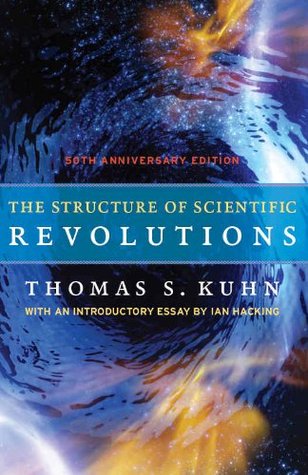More on this book
Community
Kindle Notes & Highlights
Read between
November 21, 2019 - October 9, 2021
if a typical pattern,
is applicable here, these anomalies will then no longer seem to be simply facts. From within a new theory of scientific knowledge, they may instead seem very much like tautologies, statements of situations that could not conceivably have been otherwise.
scientists fail to reject paradigms when faced with anomalies or counterinstances. They could not do so and still remain scientists.
some men have undoubtedly been driven to desert science because of their inability to tolerate crisis.
there is no such thing as research in the absence of any paradigm. To reject one paradigm without simultaneously substituting another is to reject science itself.
no paradigm that provides a basis for scientific research ever completely resolves all its problems.
Excepting those that are exclusively instrumental, every problem that normal science sees as a puzzle can be seen, from another viewpoint, as a counterinstance and thus as a source of crisis.
its object is to solve a puzzle for whose very existence the validity of the paradigm must be assumed. Failure to achieve a solution discredits only the scientist and not the theory.
“It was as if the ground had been pulled out from under one, with no firm foundation to be seen anywhere, upon which one could have built.”
explicit recognitions of breakdown are extremely rare,
the effects of crisis do not entirely depend upon its conscious recognition.
crisis may end with the emergence of a new candidate for paradigm
ensuing battle over its acceptance.
it is a reconstruction of the field from new fundamentals,
changes some of the field’s most elementary theoretical generalizations as well as many of its paradigm methods and applications.
How do scientists proceed when aware only that something has gone fundamentally wrong at a level with which their training has not equipped them to deal?
scientific revolutions are here taken to be those non-cumulative developmental episodes in which an older paradigm is replaced in whole or in part by an incompatible new one.
the sense of malfunction that can lead to crisis is prerequisite to revolution.
need seem revolutionary only to those whose paradigms are affected by them.
Like the choice between competing political institutions, that between competing paradigms proves to be a choice between incompatible modes of community life.
the choice is not and cannot be determined merely by the evaluative procedures characteristic of normal science,
for these depend in part upon a partic...
This highlight has been truncated due to consecutive passage length restrictions.
there is no standard higher than the assent of the relevant community.
paradigms differ in more than substance, for they are directed not only to nature but also back upon the science that produced them.
as the problems change, so, often, does the standard that distinguishes a real scientific solution from a mere metaphysical speculation, word game, or mathematical play.
paradigms provide scientists not only with a map but also with some of the directions essential for map-making.
learning a paradigm the scientist acquires theory, methods, and standards together, usually in an inextricable mixture.
when paradigms change, there are usually significant shifts in the criteria determining the legitimacy both of pr...
This highlight has been truncated due to consecutive passage length restrictions.
at times of revolution, when the normal-scientific tradition changes, the scientist’s perception of his environment must be re-educated—in
The assimilation of a previously anomalous visual field has reacted upon and changed the field itself.
What a man sees depends both upon what he looks at and also upon what his previous visual-conceptual experience has taught him to see.
Did these men really see different things when looking at the same sorts of objects?
they pursued their research in different worlds?
even the most striking past success provides no guarantee that crisis can be indefinitely postponed.
though the world does not change with a change of paradigm, the scientist afterward works in a different world.
Given a paradigm, interpretation of data is central to the enterprise that explores it.
Paradigms are not corrigible by normal science at all.
normal science ultimately leads only to the recognition of anomalies and to crises.
No ordinary sense of the term ‘interpretation’ fits these flashes of intuition through which a new paradigm is born.
only after experience has been thus determined that the search for an operational definition or a pure observation-language can begin.
postrevolutionary science invariably includes many of the same manipulations, performed with the same instruments and described in the same terms, as its prerevolutionary predecessor.
ultimately created an anomaly where there had been none before.
tradition of normal science. In taking
What causes the group to abandon one tradition of normal research in favor of another?
it is just the incompleteness and imperfection of the existing data-theory fit that, at any time, define many of the puzzles that characterize normal science.
It makes a great deal of sense to ask which of two actual and competing theories fits the facts better.
The proponents of competing paradigms are always at least slightly at cross-purposes.
Probably the single most prevalent claim advanced by the proponents of a new paradigm is that they can solve the problems that have led the old one to a crisis. When it can legitimately be made, this claim is often the most effective one possible.
The claim to have solved the crisis-provoking problems is, however, rarely sufficient by itself.
Nor can it always legitimately be made.


